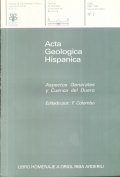El paleógeno del sector suroccidental de la Cuenca del Duero: nueva división estratigráfica y controles sobre su sedimentación
Abstract
A Paleogene four-fold stratigraphical division is proposed here as result from the detailed studies carried out during the elaboration of 22 sheets of the Geological Map of Spain (E. 1:50.000). This units (T.S.U.) are limited by regional discordances and they have a Upper Cretaceous to Oligocene ages. The previous stratigraphical schemes are rearranged due to the different stratigraphicalrelations observed between the lithostratigraphical units proPosed by other workers (Jiménez, 1970; Corrochano, 1977; Alonso, 1981 ...). An Upper Cretaceous-Paleocene age is assumed to T.S.U. MC which is mainly composed by siliciclastic sediments strongly silicified forming a FU megasequence. It is interpretated as braided streams that flowed downslope filling paleovalleys eroded onto Paleozoic materials. Mineralogical features point to a tropical climate. Lower Eocene (T.S.U. P1) is identified in the Salamanca area, where it was considered as lacking. It is composed by arkosic sediments forming a CU megasequence. Fossil faunas of this T.S.U. record a subtropical climate. It is observed a transition from high sinuosity streams to braided ones. T.S.U. P2 (Middle Eocene-Lower Oligocene) is composed of two lithostratigraphical units previously considered as bounded by a discordance (Alonso, 198 1). It has a subarkosic to lithic nature and forms a CU megasequence. This unit records a subtropical climate with short arid periods and is interpretated as braided streams showing an increasing stability and enviromental energy to the top. T.S.U. P3 (Upper Oligocene) is composed by arkosic sediments previously considered of Vallesian (Middle to Upper Miocene) age. They form a CU megasequence that records braided streams prograding basin ward from higher areas. Palinological associations and pedological features indicate an arid mediterranean climate with long arid periods and a short rainy season with strong floods. We consider that most of Lower Miocene sediments are of Paleogene age. They are afected by a widespread alteration profile developed along Lower Miocene that masked its more significative features. Sedimentological analysis of T.S.U. shows that its megasequentiality is related to the rates of tectonical uplift of source areas whereas a distensive regime developed in the sedimentation basin.


